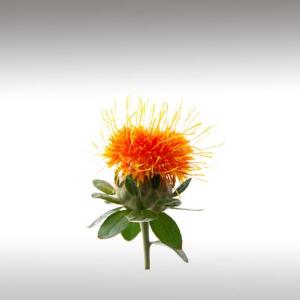
SAFFLOWER OIL (CARTHAMUS TINCTORIUS) - BASE OILS

BASE / GENERAL DATA
Information submited: June 19, 2014 Modified: May 9, 2018 By: OperaDreamhouse
Safflower (Carthamus Tinctorius) is a highly branched, herbaceous, thistle-like annual plant. It is commercially cultivated for vegetable oil extracted from the seeds. Plants are 30 to 150 cm tall with globular flower heads having yellow, orange, or red flowers.
Safflowers: both as a plant and after being pressed into an oil have had a rich history in civilizations in both the east and the west and it’s still very much viable in today’s economy and diet.
Safflower is native to arid environments having seasonal rain. It grows a deep taproot which enables it to thrive in such environments. Safflower is one of humanity's oldest crops. Chemical analysis of ancient Egyptian textiles dated to the Twelfth dynasty identified dyes made from Safflower, and garlands made from Safflowers were found in the tomb of the pharaoh Tutankhamun. Safflower was also known as carthamine in the nineteenth century.
It is a minor crop today, with about 600,000 tons being produced commercially in more than sixty countries worldwide. India, United States, and Mexico are the leading producers, with Ethiopia, Kazakhstan, China, the Arab World, Argentina and Australia accounting for most of the remainder.
The untreated seeds have a bitter taste and a somewhat dry quality so they are pressed into oil and then used as an oil in commercial production of products like soap and linoleum floor tile. The treated seeds are pressed into oil where they are then classified into two types that are both used in cooking; monounsaturated and polyunsaturated oil.
The monounsaturated oils are often advertised for their durability in cooking at high temperatures.
The polyunsaturated Safflower oil is high in linoleic acid and is used as cold oil such as mixed into salad dressings. The polyunsaturated oil is not shelf stable and must be kept in the refrigerator or in a cool location.
Safflower flowers are occasionally used in cooking as a cheaper substitute for Saffron, and were sometimes referred to as "Bastard Saffron".
Chemical structure:
Safflower seed oil is flavorless and colorless, and nutritionally similar to Sunflower oil. Safflower oil tends to carry far more Vitamin E that Olive oil.
Safflower and Sunflower oil have a significant amount in common such as they are both higher in essential fatty acids omega - 3 and omega - 6 than any other oils.
Sunflower oil contains more Vitamin E than Safflower oil, or any other oil and it is sometimes preferred for that reason. Safflower oil and Canola oil have a lot of the same great heart-disease fighting nutrients like monounsaturated fats and omega-3 fatty acids.
Safflower oil is comprised of 78,71% oleic fatty acids, 4,85% palmitic fatty acids, 12,44% linoleic fatty acids, 2,40% stearic fatty acids and 08% linoleic fatty acids. Safflower oil has the highest concentration of linoleic acid that is available on the commercial market.
Safflowers: both as a plant and after being pressed into an oil have had a rich history in civilizations in both the east and the west and it’s still very much viable in today’s economy and diet.
Safflower is native to arid environments having seasonal rain. It grows a deep taproot which enables it to thrive in such environments. Safflower is one of humanity's oldest crops. Chemical analysis of ancient Egyptian textiles dated to the Twelfth dynasty identified dyes made from Safflower, and garlands made from Safflowers were found in the tomb of the pharaoh Tutankhamun. Safflower was also known as carthamine in the nineteenth century.
It is a minor crop today, with about 600,000 tons being produced commercially in more than sixty countries worldwide. India, United States, and Mexico are the leading producers, with Ethiopia, Kazakhstan, China, the Arab World, Argentina and Australia accounting for most of the remainder.
The untreated seeds have a bitter taste and a somewhat dry quality so they are pressed into oil and then used as an oil in commercial production of products like soap and linoleum floor tile. The treated seeds are pressed into oil where they are then classified into two types that are both used in cooking; monounsaturated and polyunsaturated oil.
The monounsaturated oils are often advertised for their durability in cooking at high temperatures.
The polyunsaturated Safflower oil is high in linoleic acid and is used as cold oil such as mixed into salad dressings. The polyunsaturated oil is not shelf stable and must be kept in the refrigerator or in a cool location.
Safflower flowers are occasionally used in cooking as a cheaper substitute for Saffron, and were sometimes referred to as "Bastard Saffron".
Chemical structure:
Safflower seed oil is flavorless and colorless, and nutritionally similar to Sunflower oil. Safflower oil tends to carry far more Vitamin E that Olive oil.
Safflower and Sunflower oil have a significant amount in common such as they are both higher in essential fatty acids omega - 3 and omega - 6 than any other oils.
Sunflower oil contains more Vitamin E than Safflower oil, or any other oil and it is sometimes preferred for that reason. Safflower oil and Canola oil have a lot of the same great heart-disease fighting nutrients like monounsaturated fats and omega-3 fatty acids.
Safflower oil is comprised of 78,71% oleic fatty acids, 4,85% palmitic fatty acids, 12,44% linoleic fatty acids, 2,40% stearic fatty acids and 08% linoleic fatty acids. Safflower oil has the highest concentration of linoleic acid that is available on the commercial market.

SPIRITUAL PRACTISES DATA

MEDICINE / HEALTH DATA

BEAUTY / COSMETICS DATA

FOOD / COOKING DATA
COMMENTS
No comments.


